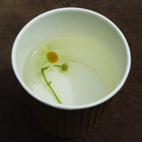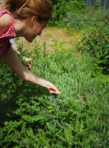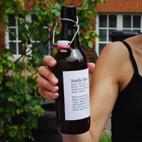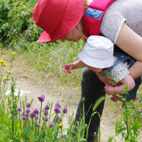The Invisible Food pack, comprising a map of wild food in the Loughborough area, info about the background to the project and a series of recipe cards and drawings was distributed to every household on the Loughborough Estate (1,259!) in the last week of April 2009.
Invisible Food has been created through a series of walks with local residents in the green spaces around the Loughborough Estate in Brixton. After walking, the participants made or cooked something such as tea, jam, cordials, quiches, soup or cakes with the herbs, flowers or berries we find. This map and bundle of recipe cards has been put together to help you explore the area and interact with the plants you find.
Invisible Food lives in the conversations held and the relationships that spring up during the walks. We’ve walked in step or with different length strides, we’ve looked at the ground or turned to each other to speak, we’ve talked about plants and what they bring us back to; childhood, games played with them, family members, herbal remedies, other countries, ‘the country’. Snippets of chats, emotions triggered by words, blasts of an idea or a different approach remain after returning home and shutting the door. Conversations held while searching out a plant never noticed before can gently blow away a confining sense of self and certainties. As Meg Wheatley writes, “Conversation is the natural way humans think together.” Whatever I or you or any one person or group knows is not enough. We need each other to fill in the gaps. I’ve pointed out some wild plants in our natural habitat, while the participants have helped me see, hear, feel and flesh out another broader context for our shared dwelling space here in Brixton. The Invisible Food Cafe – a roaming cafe of wild herb teas, jams, cakes, cordials, drawings, recipes, books and elderberry ink to doodle with – visited the Loughborough Primary school summer fair, Bonkersfest, the Lambeth Country show, Peckham Green fair, Transition Town Brixton Unleashing and People’s Republic of Southwark eco fairs in 2008.
On another level, Invisible Food explores approaches to play, and peak experiences that can surface through play. I’ve identified peak experiences as moments lost in an activity when time stops, or when relationship to time is punctured and its pressure released. These are moments which impart a strong physical memory beyond the ordinary consciousness of everyday life. There was scope for these peak experiences during the project through contact with nature and through exploratory play. In searching for wild food, we had to enter into an attitude of play, of allowing the unknown and the new to come into frame. We could free ourselves from a body which rehearses patterns of behaviour, such as getting from A to B as fast as possible, looking in a fixed direction and blocking out the context of habitat. We had to alter our route, pace, and eye level. The absorption of our bodies in the environment changes patterns or reveals something not noticed before. The blackberries are there to lose ourselves in.
Invisible Food is a tool to learn about wild plants and it offers another way of perceiving London. We live in a society with a largely uncontested belief that competition amongst experts creates strong and healthy systems, but we haven’t spent nearly enough time noticing how cooperation and interdependence can create resilience and strength. The words, drawings, photos and map point out plants in their urban habitat and invite you to take your own walk of discovery.
Map
Recipe cards




